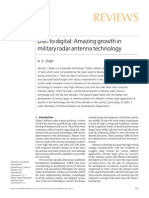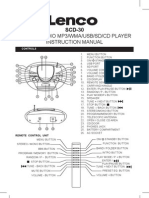Microwave Remote Sensing: Rucha Joshi (M.Tech) Assistant Professor Geoinformatics Division University of Pune
Microwave Remote Sensing: Rucha Joshi (M.Tech) Assistant Professor Geoinformatics Division University of Pune
Uploaded by
रुचा जोशीCopyright:
Available Formats
Microwave Remote Sensing: Rucha Joshi (M.Tech) Assistant Professor Geoinformatics Division University of Pune
Microwave Remote Sensing: Rucha Joshi (M.Tech) Assistant Professor Geoinformatics Division University of Pune
Uploaded by
रुचा जोशीOriginal Title
Copyright
Available Formats
Share this document
Did you find this document useful?
Is this content inappropriate?
Copyright:
Available Formats
Microwave Remote Sensing: Rucha Joshi (M.Tech) Assistant Professor Geoinformatics Division University of Pune
Microwave Remote Sensing: Rucha Joshi (M.Tech) Assistant Professor Geoinformatics Division University of Pune
Uploaded by
रुचा जोशीCopyright:
Available Formats
MICROWAVE REMOTE SENSING
Rucha Joshi (M.Tech)
Assistant Professor
Geoinformatics Division
University of Pune.
EM SPECTRUM
Microwave region
Millimeter wave
30 GHz 300 GHz.
OR
1mm to 1m
MICROWAVE REMOTE SENSING: PRINCIPLES
AND APPLICATIONS.
Advantages
Day/night coverage.
All weather except during
periods of heavy rain.
Penetrates atmosphere under
virtually all conditions
Microwave reflections/
emissions from earth
materials bear no direct
relationship to counterparts in
visible or thermal portions.
Disadvantages
Data are difficult to interpret.
Coarse resolution except for
SAR.
4
ADVANTAGES OF RADAR
All weather, day or night
Some areas of Earth are persistently cloud
covered
Penetrates clouds, vegetation, dry soil, dry
snow
Sensitive to water content, surface roughness
Can measure waves in water
Sensitive to polarization and frequency
Interferometry (later) using 2 receiving
antennas
5
DISADVANTAGES OF RADAR
Penetrates clouds, vegetation, dry soil, dry snow
Signal is integrated over a depth range and a variety
of materials
Sensitive to water content, surface roughness
Small amounts of water affect signal
Hard to separate the volume response from the
surface response
Sensitive to polarization and frequency
Many choices for instrument, expensive to cover
range of possibilities
The math can be formidable
6
ACTIVE AND PASSIVE REMOTE SENSING
Passive: uses natural energy, either reflected sunlight or emitted
thermal or microwave radiation
Passive Microwave Sensors are radiometers (Multi frequency
scanning/ imaging radiometers, atmospheric sounder).
Active: sensor creates its own energy
Transmitted toward Earth
Interacts with atmosphere and/or surface
Reflects back toward sensor (backscatter)
Active microwave sensors include SLR/SLAR, SAR, Active
Microwave Imager (AMI), Scatterometer (SLR), Altimeter, Rain
Mapping Radar, etc.
ADVANCED MULTI SCANNING/ IMAGING RADIOMETER
ATMOSPHERIC SOUNDER
9
WIDELY USED ACTIVE REMOTE SENSING
SYSTEMS
Active microwave (Radar)
long-wavelength microwaves (1-100cm)
recording the amount of energy back-scattered from the
terrain
Lidar
short-wavelength laser light (e.g., 0.90 m)
recording the light back-scattered from the terrain or
atmosphere
Sonar
sound waves through a water column
recording the amount of energy back-scattered from the
water column or the bottom
10
MICROWAVE BAND CODES
Band Wavelength, cm Frequency, GHz
Mid-IR
(3-5)10
4
100,000-60,000
Thermal IR
(8-15) 10
4
37,500-20,000
K
a
0.75-1.18 40.0-26.5
K 1.19-1.67 26.5-18.0
K
u
1.67-2.4 18.0-12.5
X 2.4-3.8 12.5-8.0
C 3.9-7.5 8.0-4.0
S 7.5-15.0 4.0-2.0
L 15.0-30.0 2.0-1.0
P 30.0-100 1.0-0.3
Unusual names
are an artifact of
the original
secret work on
radar remote
sensing in World
War II
SIR-C/X-SAR
IMAGES OF
RONDONIA,
BRAZIL
April 10, 1994
SENDING AND RECEIVING A PULSE OF
MICROWAVE RADIATION
transmitted pulse
backscattered pulse
ant enna
Transmitt er
Duplexer
sends and
receives
Pulse
Generat or
CRT Display or
Digital Recorder
Receiver
b.
a.
antenna
HOW IT WORKS
Pulses of active microwave
electromagnetic energy
illuminate strips of the
terrain at right angles
(orthogonal) to the direction
of travel
called the range or look
direction
The terrain illuminated
nearest the aircraft is the
near-range
The farthest point of
terrain illuminated is the
far-range
HOW IT WORKS (CONT.)
Aircraft or satellite travels in a straight line: the azimuth direction
Pulses of microwave electromagnetic energy illuminate strips of the
terrain orthogonal to direction of travel: the range or look direction
Terrain illuminated nearest the sensor in the line of sight is the near-
range
The farthest point of terrain illuminated by the pulse of energy is the
far-range
Generally, objects that trend (or strike) in a direction orthogonal
(perpendicular) to the range or look direction are enhanced much
more than those objects in the terrain that lie parallel to the look
direction
Consequently, linear features that are imperceptible in a radar image
using one look direction may appear bright in another radar image with
a different look direction.
NOMENCLATURE
nadir
azimuth flight direction
look direction
range (near and far)
depression angle ()
incidence angle ()
altitude above-ground-
level, H
polarization
DEPRESSION ANGLES AND INCIDENCE
ANGLES
Depression angle (): between a horizontal
plane extending out from the sensor and the
electromagnetic pulse of energy from the
antenna to a specific point on the ground
Incidence angle (u): between the radar pulse
and the normal to Earths surface
When surface is flat, u = 90
Polarization
HH, VV are like polarized
HV, VH are cross polarized
E
E
Linear Elliptical Circular
y
y y
E
x
x
x
POLARIZATION
1
st
letter is
transmitted
polarization,
2
nd
is received
Can have
VV, HH
(like)
HV, VH
(cross)
POLARIZATION WITH VISIBLE
LIGHT
In this case, incoming
radiation (sunlight) is not
polarized (or is polarized
in both directions)
Vertically polarized light
is reflected from surface
At this view angle,
horizontally polarized
light is not reflected
So horizontal filter
allows us to see the
bottom
POLARIZATION
WITH RADAR
a.
b.
look direction
N
K
a
- band, HH polarization
K
a
- band, HV polarization
VARIABILITY WITH
LOOK DIRECTION
a.
b.
look direction
X - band, HH polarization look direction
s
X - band, HH polarization
RANGE RESOLUTION
( )
pulse length speed of light
2cos 2cos depression angle
r
c
R
t
= =
AZIMUTH RESOLUTION
slant range wavelength
antenna length
a
S
R
L
=
RADAR IMAGE
FORESHORTENING,
LAYOVER, SHADOW
Geometric
distortions in all
radar imagery
FORESHORTENIN
G
LAYOVER
LAYOVER
Extreme case of
foreshortening,
when incidence
angle is less than
slope angle
toward radar (i.e.
<)
cannot be
corrected
got to be
careful in the
mountains
SHADOW
SHADOW
When slope away from radar is steeper than the
depression angle, i.e. >
Foreshortening Layover Shadow
Geometric Effects
SPECKLE
Grainy salt-and-pepper pattern in
radar imagery
Caused by coherent nature of
the radar wave, which causes
random constructive and
destructive interference, and
hence random bright and dark
areas in a radar image
Reduced by multiple looks
processing separate portions of
an aperture and recombining
these portions so that
interference does not occur
SYNTHETIC APERTURE RADAR (SAR)
Major advance in radar remote sensing to
improve azimuth resolution by synthesizing a
long antenna
Recall
slant range wavelength
antenna length
a
S
R
L
=
SYNTHETIC APERTURE RADAR (SAR)
38
RADAR EQUATION
( )
2 2
3
4
4
power received
power transmitted
antenna gain in direction of target
range distance from transmitter to target
backscatter area of target
wavelength
t t
r
r
t
t
PG
P
R
P
P
G
R
o
t
o
=
39
RADAR BACKSCATTER
COEFFICIENT
Primary signal of interest
Percentage of electromagnetic energy
reflected back to the radar from within a
resolution cell
Depends on terrain parameters like
geometry, surface roughness, moisture
content, and
radar system parameters (wavelength,
depression angle, polarization, etc.)
0
A
o
o =
ROUGHNESS
Smooth
25sin
Rough
4.4sin
h
h
s
>
NILE RIVER, SUDAN
Space
shuttle
color
VNIR
SIR-C Color
Composite:
Red: C-band HV
Green: L-band
HV
Blue: L-band HH
SOURCES OF
RADAR
BACKSCATTERI
NG FROM A
VEGETATION
CANOPY
Subscripts
t trunk
s soil
c leaves
m multiple
TYPES OF
SCATTERING
FROM A PINE
STAND
STRENGTH OF SCATTERING FROM A PINE STAND
DEPENDS ON FREQUENCY
Radarsart
2
2003
HH,VV,
HV, VH
Advanced Land Observing Satellite
(ALOS) 2004
PALSAR (Phased array SAR)
PRISM
LightSAR (USA & Germany
L- and X-band
All Polarizations
RISAT (Radar Imaging Satellite)
C-band in 3 modes
Cryosat
Radar Altimeter Mission
Determine the variation in the thickness of the Ice
sheets to be planned to Launch 2004
Range Resolution
4.6 cm, accuracy
1 or 2 cm
Launch year - 2006
Frequency = 5.35 GHz
Resolution HRS 1-2 m with
Swath 10 x 10 km, single/dual
polarization
FRS-1 mode 3-6 m with swath
30 km, single/dual polarization
FRS-2 model 9-12, with swath
30 km, Quad polarization
MRS/CRS mode 25- 50 m, with
swath 120/240 km, single/quad
Indian RISAT SAR
RADARSAT-2 (LAUNCHED DEC 2007)
C-band radar (5.4 GHz) with HH,
VV, HV, and VH polarizations
51
SIR-C/X-SAR WEB SITE AT JPL
SIR-C
Spaceborne Imaging Radar-C (following SIR-A
in 1981 and SIR-B in 1984)
X-SAR
X-band Synthetic Aperture Radar (built by
Germans)
Flew on Shuttle, 2 10-day missions in 1994
Thank you!!!
You might also like
- Radar Fundamentals 2Document56 pagesRadar Fundamentals 2Chandan MishraNo ratings yet
- Assignment RadarDocument11 pagesAssignment RadarAnand Krishnan P V0% (1)
- Remote SensingDocument18 pagesRemote Sensingpowerman619No ratings yet
- Synthetic Aperture Radar: Presented By: LT CDR Abhinaw Kumar Guide: Prof Kushal TuckleyDocument26 pagesSynthetic Aperture Radar: Presented By: LT CDR Abhinaw Kumar Guide: Prof Kushal TuckleyAbhinaw Kumar100% (1)
- Risat 1Document12 pagesRisat 1ramulu_492No ratings yet
- Sar Image FormationDocument15 pagesSar Image FormationMusyarofah HanafiNo ratings yet
- Multi-Standard Receiver DesignDocument54 pagesMulti-Standard Receiver DesignWalid_Sassi_TunNo ratings yet
- Satellite Space and Earth Segment - Lecture NotesDocument42 pagesSatellite Space and Earth Segment - Lecture NotesHidayah KamaludinNo ratings yet
- Micro PDFDocument55 pagesMicro PDFHem BhattaraiNo ratings yet
- FMCW Radar Is A Special Type of Radar Sensor Which Radiates: Frequency-Modulated Continuous-Wave RadarDocument8 pagesFMCW Radar Is A Special Type of Radar Sensor Which Radiates: Frequency-Modulated Continuous-Wave RadarSummer KoNo ratings yet
- Use of Communication in Radar SystemDocument5 pagesUse of Communication in Radar SystemKathryn Patton100% (1)
- FMCW PrincipeDocument21 pagesFMCW PrincipeTom GNo ratings yet
- Radar Part2Document39 pagesRadar Part2Agung B CahyonoNo ratings yet
- Amazing Growth in Military Radar Antenna TechnologyDocument39 pagesAmazing Growth in Military Radar Antenna Technologyagmnm1962100% (1)
- Smallsat Cubesat IDocument61 pagesSmallsat Cubesat IVisal KelNo ratings yet
- Satellite CommunicationDocument36 pagesSatellite Communicationتميم مسعودNo ratings yet
- Ch5-Radar Target and ClutterDocument44 pagesCh5-Radar Target and ClutterWesley GeorgeNo ratings yet
- Bellringer: Explain in Complete SentencesDocument89 pagesBellringer: Explain in Complete SentencesPramod AroteNo ratings yet
- Fundamentals Satellite Communication Part 2Document50 pagesFundamentals Satellite Communication Part 2mesutirmak7681100% (2)
- Linear Phased Array Antenna2Document19 pagesLinear Phased Array Antenna2AnilLazyNo ratings yet
- Teacher NotesDocument8 pagesTeacher Notesapi-410486717No ratings yet
- Assignment SONAR Experiment FullDocument12 pagesAssignment SONAR Experiment FullPykah Watif100% (1)
- Literature Review of Direction Finding AntennasDocument29 pagesLiterature Review of Direction Finding AntennasVaishali SinghNo ratings yet
- Lidar PresentationDocument13 pagesLidar PresentationNelson lubangaNo ratings yet
- Radar 1Document67 pagesRadar 1mancangkulNo ratings yet
- MIMO Radar A Idea Whose Time Has ComeDocument8 pagesMIMO Radar A Idea Whose Time Has Cometrongnguyen29No ratings yet
- Final ReportDocument43 pagesFinal ReportRajat RathiNo ratings yet
- Space Wave PropagationDocument40 pagesSpace Wave Propagationece4 2015No ratings yet
- EITN90 Radar and Remote Sensing Lecture 10: Machine Learning Approaches To Radar Signal AnalysisDocument49 pagesEITN90 Radar and Remote Sensing Lecture 10: Machine Learning Approaches To Radar Signal Analysiswire010No ratings yet
- Satellite TutorialDocument2 pagesSatellite Tutorialtarunch89100% (1)
- Cenk EngDocument2 pagesCenk EngMuhammad HilmiNo ratings yet
- LiMapperUserGuide enDocument88 pagesLiMapperUserGuide enHendra SumarjaNo ratings yet
- .Define X-Ray? Write Down The Properties of X-Ray?Document32 pages.Define X-Ray? Write Down The Properties of X-Ray?Sabbir HossainNo ratings yet
- Steerable AntennaDocument44 pagesSteerable AntennaKenNediaNo ratings yet
- Sonar (Sound Navigation and Ranging) : Principle of An Active Sonar - Send and Return PingsDocument15 pagesSonar (Sound Navigation and Ranging) : Principle of An Active Sonar - Send and Return Pingsmonikajoon29100% (1)
- Sattelite CommunicationDocument31 pagesSattelite CommunicationSreekanth EnduruNo ratings yet
- RADAR NotesDocument46 pagesRADAR Notessebastian hezronNo ratings yet
- IDEA Murwell Detectors VCI 2022Document15 pagesIDEA Murwell Detectors VCI 2022Mahmoud Abd-Elhay AlthaqelNo ratings yet
- Radar SystemsDocument156 pagesRadar SystemsVed RajNo ratings yet
- Space DynamicsDocument4 pagesSpace DynamicsShubham ShekharNo ratings yet
- Brief Introduction To Radio AstronomyDocument10 pagesBrief Introduction To Radio AstronomyFreedomNo ratings yet
- Gps Receiver Design TutorialDocument3 pagesGps Receiver Design TutorialPete100% (1)
- Antenna PrimerDocument102 pagesAntenna PrimerWaqar AhmadNo ratings yet
- Satellite CommunicationDocument29 pagesSatellite Communicationمعين أحمد الجماعي100% (1)
- 826 InSAR Basics-F15Document79 pages826 InSAR Basics-F15Moises Rodrigo100% (2)
- Unit 9 Radar CluttersDocument78 pagesUnit 9 Radar CluttersVinamra KumarNo ratings yet
- Sonar: - Swapnil Hole (17) - Akshay Bramhane (18) - Amey Dandge (19) - Kshitij S. Dasture (20) Prof.P.A.PATHADEDocument30 pagesSonar: - Swapnil Hole (17) - Akshay Bramhane (18) - Amey Dandge (19) - Kshitij S. Dasture (20) Prof.P.A.PATHADEChinmay ApasangiNo ratings yet
- Final MTech ProjectDocument30 pagesFinal MTech ProjectArunSharmaNo ratings yet
- Ocean Propagation Models PDFDocument39 pagesOcean Propagation Models PDFkumargpalaniNo ratings yet
- Velocity of Sound in Liquid PDFDocument8 pagesVelocity of Sound in Liquid PDFDeniz Akoum100% (1)
- Satellite Communication & Networking: Sumbitted byDocument10 pagesSatellite Communication & Networking: Sumbitted bySanket KingHeartNo ratings yet
- inSAR Processing For DEM Generation PDFDocument8 pagesinSAR Processing For DEM Generation PDFJohn GkanatsiosNo ratings yet
- Radar and Navigational AidsDocument1 pageRadar and Navigational AidsPatel Vivek0% (1)
- Ni Aesa Radar e BookDocument24 pagesNi Aesa Radar e BookCláudioSaundersFilhoNo ratings yet
- Satellite Imagery TypesDocument50 pagesSatellite Imagery TypesArtanto Rizky CahyonoNo ratings yet
- LEO Satellite Constellation For Internet of ThingsDocument11 pagesLEO Satellite Constellation For Internet of ThingslucasolveigaNo ratings yet
- RadarDocument21 pagesRadarYogesh DhawanNo ratings yet
- Global Positioning: Technologies and PerformanceFrom EverandGlobal Positioning: Technologies and PerformanceRating: 5 out of 5 stars5/5 (1)
- The SatNav Users Guide to Navigation and Mapping Using GPSFrom EverandThe SatNav Users Guide to Navigation and Mapping Using GPSRating: 1 out of 5 stars1/5 (2)
- Operation GOTCHA: The Soviet Union's Top-Secret Plan to Launch a Surprise Cruise Missile Attack Against the United StatesFrom EverandOperation GOTCHA: The Soviet Union's Top-Secret Plan to Launch a Surprise Cruise Missile Attack Against the United StatesNo ratings yet
- Bonding JumpersDocument7 pagesBonding Jumpersvladimir rosas ayalaNo ratings yet
- AY2010 CE2134 Hydraulics E02 Fluid Statics & Floating BodiesDocument22 pagesAY2010 CE2134 Hydraulics E02 Fluid Statics & Floating BodiesEmily ShumNo ratings yet
- Project: Audio Amplifier: Electronic Circuit IDocument16 pagesProject: Audio Amplifier: Electronic Circuit INguyen Cong HuynhNo ratings yet
- Transfer Function Vs State SpaceDocument2 pagesTransfer Function Vs State SpaceD.Viswanath0% (2)
- 2384 TSSR ReportDocument11 pages2384 TSSR ReportSami DohaNo ratings yet
- Lenco SCD-30 Manual ENGDocument8 pagesLenco SCD-30 Manual ENGJelenaMiticNo ratings yet
- UniPack Mercury - NSDocument2 pagesUniPack Mercury - NSJauhary HarrysNo ratings yet
- Mazda CX 9 AWD Owners ManualDocument592 pagesMazda CX 9 AWD Owners Manualh5vrp5vhqcNo ratings yet
- Mathematical Petrophysics PDFDocument28 pagesMathematical Petrophysics PDFLia Oktaviani KusmawanNo ratings yet
- WappstackDocument14 pagesWappstackcacink 25No ratings yet
- DP Quiz 4Document5 pagesDP Quiz 4chNo ratings yet
- Robinson R22 Specification and Dimensions For FamiliarizationDocument3 pagesRobinson R22 Specification and Dimensions For FamiliarizationJohn JedNo ratings yet
- Balance Score Card and Just in TimeDocument23 pagesBalance Score Card and Just in TimePoojaVartakNo ratings yet
- rm32lz50 PDFDocument40 pagesrm32lz50 PDFPilar Sarmiento NuñezNo ratings yet
- Design Stress For Vinyl Sheet PileDocument4 pagesDesign Stress For Vinyl Sheet PileSøren MørchNo ratings yet
- Grade 10 Consumer Electronics Servicing NC IiDocument2 pagesGrade 10 Consumer Electronics Servicing NC IiCarl Jerome Borja100% (1)
- September 2018 AMSOIL Dealer EditionDocument24 pagesSeptember 2018 AMSOIL Dealer EditionamsoildealerNo ratings yet
- Wisescan Interface Options and Controls For Contex Scanners: Main Scanning Toolbar (Direct Support)Document23 pagesWisescan Interface Options and Controls For Contex Scanners: Main Scanning Toolbar (Direct Support)José Pedro Mendoza RíosNo ratings yet
- 2011 Chevrolet Camaro CoupeDocument2 pages2011 Chevrolet Camaro CoupeexnihilogNo ratings yet
- Silo BucklingDocument14 pagesSilo BucklingrahilmlNo ratings yet
- Project On Larsen & Turbo LimitedDocument24 pagesProject On Larsen & Turbo LimitedEhtesham Ahmed100% (1)
- Is 276 2000Document12 pagesIs 276 2000gotosudNo ratings yet
- Identity and Reputation Systems On EthereumDocument8 pagesIdentity and Reputation Systems On EthereumDavid KrmpoticNo ratings yet
- ELSSG04Document18 pagesELSSG04Ariel Anibal AparicioNo ratings yet
- Model Pemanasan Dalam Bentuk Bermain Pada Pembelajaran Sepakbola Bagi Siswa Sekolah DasarDocument11 pagesModel Pemanasan Dalam Bentuk Bermain Pada Pembelajaran Sepakbola Bagi Siswa Sekolah Dasarari wibowoNo ratings yet
- Schedule 30 06Document68 pagesSchedule 30 06Dedy DharmawansyahNo ratings yet
- IT Recruitment Support - TrainingDocument12 pagesIT Recruitment Support - TrainingOlivia Ioana Franculescu100% (1)
- BOM Configuration - BOM Modification Parameters - SCNDocument12 pagesBOM Configuration - BOM Modification Parameters - SCNvlkrizNo ratings yet
- Math Reviewer On Civil ServiceDocument5 pagesMath Reviewer On Civil ServiceLiezl OctavoNo ratings yet
- SN.1-Circ.265 - Guidelines On The Application of Solas Regulation V15 To Ins, Ibs and Bridge Design (Secretariat)Document5 pagesSN.1-Circ.265 - Guidelines On The Application of Solas Regulation V15 To Ins, Ibs and Bridge Design (Secretariat)Clarence PieterszNo ratings yet

























































































